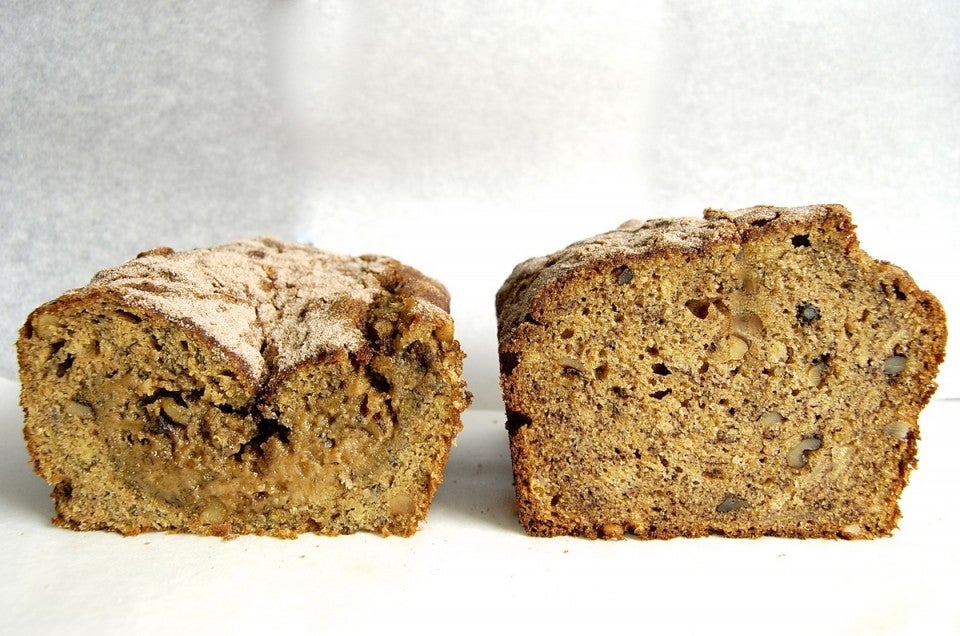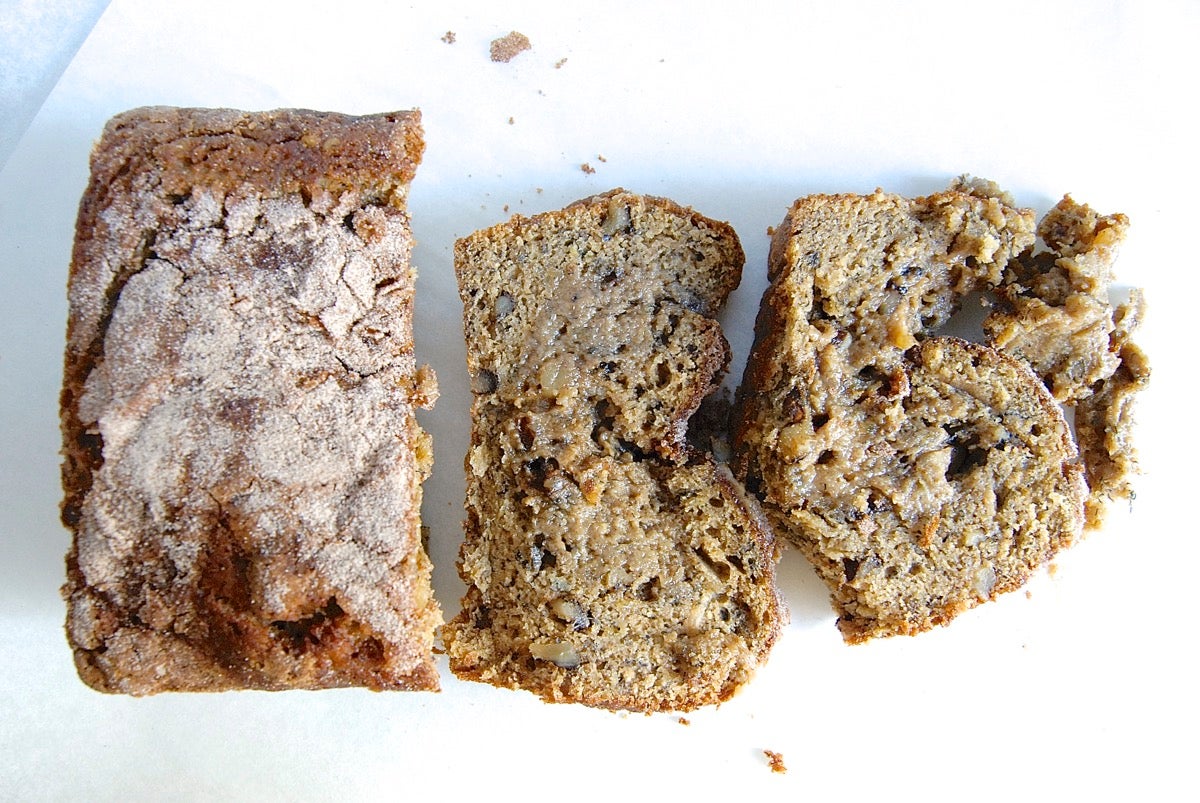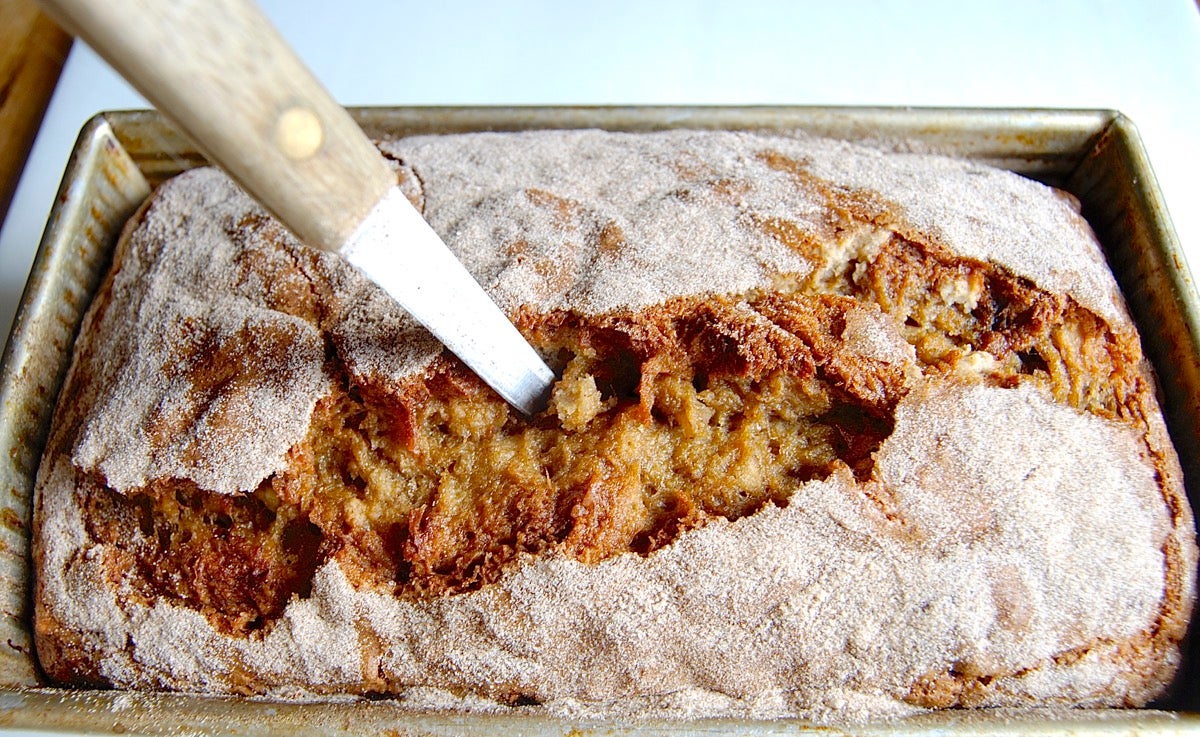


Have you ever cut open a loaf of banana bread (or any quick bread, for that matter), and found, to your great chagrin, a sphere of gooey, uncooked batter in the center?
You sigh; you salvage both ends of the loaf. But there’s no choice except to cut the heart out of your bread (literally!), and throw it away.

How sad is that?
What’s the best way to ensure that your banana bread, pumpkin bread, or zucchini bread is baked all the way through — the center perfect, the sides not tough and overbaked, the top crust a deep golden brown but not burned?
Here are five things you can do to ensure that banana bread — or any quick bread — is perfectly baked every time.
Make sure your oven is calibrated correctly
If your recipe calls for baking bread at 350°F, and your oven’s actual temperature is 315°F (despite it being set to 350°F), your bread isn’t going to be done when you think it is.

Solution: at least one external (portable) oven thermometer, a thermometer you can hang from (or rest on) your oven’s center rack.
I use two thermometers, so I can double check them against one another; if they register the same temperature (or within a few degrees), then I know they're accurately reading the oven's temperature.
Preheat your oven thoroughly
My oven tells me (BEEP!) it’s fully preheated in 10 minutes. Liar liar, pants on fire! It actually takes my oven nearly 25 minutes of preheating to reach 350°F.

How do you know when your oven is fully preheated?
Set your oven temperature to 350°F, and turn it on. Start a timer. Use an external (portable) oven thermometer (see above) to accurately gauge the oven's temperature.
When your oven reaches the desired temperature, stop the timer and see how long it took. Going forward, assume this amount of time is necessary for preheating.
Obviously the time will vary depending on what temperature you're preheating to, but the amount of time needed to preheat your oven to 350°F is a good benchmark.
Position the pan in the oven optimally
I used to have a lot of trouble with my quick breads having a thin uncooked layer right at the top. Solution? Moving the oven rack up a notch, so it’s closer to the heating element (6” from element to pan rim; yes, I measured). To prevent the top crust from burning, I tent the bread with aluminum foil for the final third of its baking time (typically 20 to 25 minutes).

Now, that’s what works for me; if you have an oven with a bottom heating element, you may want to position the pan closer to the bottom — or not. Experiment until you find the best spot in your oven for optimal quick-bread baking.
Test for doneness using a thermometer
You know how you stick a toothpick or cake tester into the center of a baking cake to see if it’s done? This works with quick breads, as well — some of the time.
Other times, if the batter is “textured” with bits of banana or zucchini, or added chips or dried fruit, the test is unreliable.

Instead of using a cake tester or toothpick to test quick bread, try using a thin-bladed knife (like a paring knife). Push the blade into the center; draw it out. You may or may not see any wet batter or moist crumbs clinging to the blade.

Repeat the test; I've found that oftentimes the first insertion doesn't yield any telltale wet batter, but the second one does. If after two or three attempts the knife doesn't show any wet batter, you're probably good to go.
Probably.
The only truly reliable tool I’ve found for testing the doneness of quick bread is a digital thermometer.
When you think your bread is done, stick the thermometer straight down through the top-center of the loaf. Gradually draw it out, checking readings along the way. You’ll see the temperature drop as the probe moves from bottom to center, then rise again as you start to withdraw it.

When the center of your bread is baked through a thermometer will register between 200°F and 205°F. No part of your loaf should be below 200°F — except perhaps the very top, which may produce an unreliable reading due to the thermometer’s tip being partially exposed to room-temperature air. Note: For those of you baking gluten-free quick breads, your finished temperature should be 205°F to 210°F.
Know your own oven, pan, and recipe — and take notes
Did you ever wonder why your mom’s brownies are always perfect and yours are always overbaked?
Because you’re using her recipe, and your mom’s oven might bake very differently than your own. Know your oven.

Your favorite old glass pan might bake more slowly than that new stainless steel pan you tried; which in turn will bake more slowly than your workhorse aluminum pan. Know your pan.
Your zucchini bread seems to bake more quickly than pumpkin bread. And that lemon bread? Done WAY before your banana bread. Know your recipe.
The takeaway here? Take notes as you bake: what pan you use, how long you preheat your oven, where you position your oven rack, whether or not you tent the loaf with aluminum foil towards the end.
Are you adding chocolate chips? Substituting honey for some of the brown sugar? Any change you make to your original recipe may change its baking time.

Write those changes down. And next time you bake your favorite banana bread you won’t have to wonder, “Is it done?” You’ll know.
If you've cut into a loaf of quick bread and discovered its center is raw, it's no use putting it back into the oven. Its edges and crust will dry out before the interior cooks.
Better to cut that soggy interior into slices and cook them on a griddle. Fry up some bacon, plate your banana "French toast," and no one will be the wiser!

